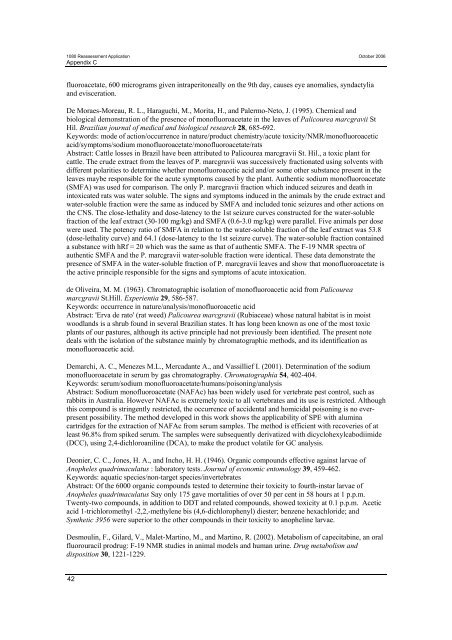Source: Landcare Research (1964). Control of poisons. Royal ...
Source: Landcare Research (1964). Control of poisons. Royal ...
Source: Landcare Research (1964). Control of poisons. Royal ...
You also want an ePaper? Increase the reach of your titles
YUMPU automatically turns print PDFs into web optimized ePapers that Google loves.
1080 Reassessment Application October 2006<br />
Appendix C<br />
fluoroacetate, 600 micrograms given intraperitoneally on the 9th day, causes eye anomalies, syndactylia<br />
and evisceration.<br />
De Moraes-Moreau, R. L., Haraguchi, M., Morita, H., and Palermo-Neto, J. (1995). Chemical and<br />
biological demonstration <strong>of</strong> the presence <strong>of</strong> mon<strong>of</strong>luoroacetate in the leaves <strong>of</strong> Palicourea marcgravii St<br />
Hil. Brazilian journal <strong>of</strong> medical and biological research 28, 685-692.<br />
Keywords: mode <strong>of</strong> action/occurrence in nature/product chemistry/acute toxicity/NMR/mon<strong>of</strong>luoroacetic<br />
acid/symptoms/sodium mon<strong>of</strong>luoroacetate/mon<strong>of</strong>luoroacetate/rats<br />
Abstract: Cattle losses in Brazil have been attributed to Palicourea marcgravii St. Hil., a toxic plant for<br />
cattle. The crude extract from the leaves <strong>of</strong> P. marcgravii was successively fractionated using solvents with<br />
different polarities to determine whether mon<strong>of</strong>luoroacetic acid and/or some other substance present in the<br />
leaves maybe responsible for the acute symptoms caused by the plant. Authentic sodium mon<strong>of</strong>luoroacetate<br />
(SMFA) was used for comparison. The only P. marcgravii fraction which induced seizures and death in<br />
intoxicated rats was water soluble. The signs and symptoms induced in the animals by the crude extract and<br />
water-soluble fraction were the same as induced by SMFA and included tonic seizures and other actions on<br />
the CNS. The close-lethality and dose-latency to the 1st seizure curves constructed for the water-soluble<br />
fraction <strong>of</strong> the leaf extract (30-100 mg/kg) and SMFA (0.6-3.0 mg/kg) were parallel. Five animals per dose<br />
were used. The potency ratio <strong>of</strong> SMFA in relation to the water-soluble fraction <strong>of</strong> the leaf extract was 53.8<br />
(dose-lethality curve) and 64.1 (dose-latency to the 1st seizure curve). The water-soluble fraction contained<br />
a substance with hRf = 20 which was the same as that <strong>of</strong> authentic SMFA. The F-19 NMR spectra <strong>of</strong><br />
authentic SMFA and the P. marcgravii water-soluble fraction were identical. These data demonstrate the<br />
presence <strong>of</strong> SMFA in the water-soluble fraction <strong>of</strong> P. marcgravii leaves and show that mon<strong>of</strong>luoroacetate is<br />
the active principle responsible for the signs and symptoms <strong>of</strong> acute intoxication.<br />
de Oliveira, M. M. (1963). Chromatographic isolation <strong>of</strong> mon<strong>of</strong>luoroacetic acid from Palicourea<br />
marcgravii St.Hill. Experientia 29, 586-587.<br />
Keywords: occurrence in nature/analysis/mon<strong>of</strong>luoroacetic acid<br />
Abstract: 'Erva de rato' (rat weed) Palicourea marcgravii (Rubiaceae) whose natural habitat is in moist<br />
woodlands is a shrub found in several Brazilian states. It has long been known as one <strong>of</strong> the most toxic<br />
plants <strong>of</strong> our pastures, although its active principle had not previously been identified. The present note<br />
deals with the isolation <strong>of</strong> the substance mainly by chromatographic methods, and its identification as<br />
mon<strong>of</strong>luoroacetic acid.<br />
Demarchi, A. C., Menezes M.L., Mercadante A., and Vassillief I. (2001). Determination <strong>of</strong> the sodium<br />
mon<strong>of</strong>luoroacetate in serum by gas chromatography. Chromatographia 54, 402-404.<br />
Keywords: serum/sodium mon<strong>of</strong>luoroacetate/humans/poisoning/analysis<br />
Abstract: Sodium mon<strong>of</strong>luoroacetate (NAFAc) has been widely used for vertebrate pest control, such as<br />
rabbits in Australia. However NAFAc is extremely toxic to all vertebrates and its use is restricted. Although<br />
this compound is stringently restricted, the occurrence <strong>of</strong> accidental and homicidal poisoning is no everpresent<br />
possibility. The method developed in this work shows the applicability <strong>of</strong> SPE with alumina<br />
cartridges for the extraction <strong>of</strong> NAFAc from serum samples. The method is efficient with recoveries <strong>of</strong> at<br />
least 96.8% from spiked serum. The samples were subsequently derivatized with dicyclohexylcabodiimide<br />
(DCC), using 2,4-dichloroaniline (DCA), to make the product volatile for GC analysis.<br />
Deonier, C. C., Jones, H. A., and Incho, H. H. (1946). Organic compounds effective against larvae <strong>of</strong><br />
Anopheles quadrimaculatus : laboratory tests. Journal <strong>of</strong> economic entomology 39, 459-462.<br />
Keywords: aquatic species/non-target species/invertebrates<br />
Abstract: Of the 6000 organic compounds tested to determine their toxicity to fourth-instar larvae <strong>of</strong><br />
Anopheles quadrimaculatus Say only 175 gave mortalities <strong>of</strong> over 50 per cent in 58 hours at 1 p.p.m.<br />
Twenty-two compounds, in addition to DDT and related compounds, showed toxicity at 0.1 p.p.m. Acetic<br />
acid 1-trichloromethyl -2,2,-methylene bis (4,6-dichlorophenyl) diester; benzene hexachloride; and<br />
Synthetic 3956 were superior to the other compounds in their toxicity to anopheline larvae.<br />
Desmoulin, F., Gilard, V., Malet-Martino, M., and Martino, R. (2002). Metabolism <strong>of</strong> capecitabine, an oral<br />
fluorouracil prodrug: F-19 NMR studies in animal models and human urine. Drug metabolism and<br />
disposition 30, 1221-1229.<br />
42








![Application for test certificate [pdf, 131kb]](https://img.yumpu.com/50666502/1/184x260/application-for-test-certificate-pdf-131kb.jpg?quality=85)








